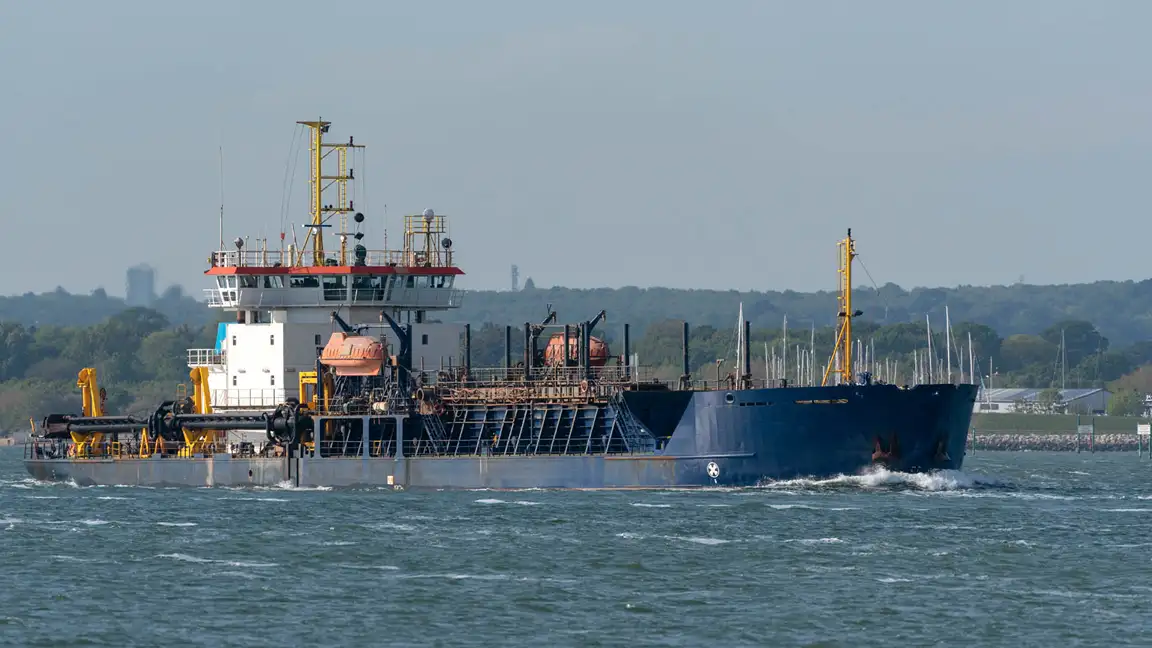UXO Survey
Boskalis, a global leader in dredging and maritime services, recently completed a key dredging project in Southampton, UK. Dredging is a crucial operation for maintaining the accessibility of ports, ensuring smooth passage for vessels, and facilitating international trade. The project in Southampton involved utilizing some of Boskalis’ most advanced equipment, including trailing suction hopper dredgers (TSHDs) and backhoe dredgers, to remove dense material from the access channel and jetty area. This article takes a closer look at the operation, its phases, and the technology used.
Before any dredging operations could begin, a detailed survey was conducted to check for unexploded ordnance (UXO) or objects of potential archaeological interest in the area. This phase is critical for ensuring the safety of the workers and preventing any accidental damage to historical or hazardous objects.
Boskalis surveyed 73 targets in the dredging area. After a thorough inspection, the team confirmed that no UXOs or significant archaeological objects were present, allowing the work to proceed without further delays. This careful precaution ensured a safe working environment for the team and avoided potential disruptions to the project.
Dredging Operations
Once the area was cleared of hazards, the second phase of the project began: dredging 200,000 cubic meters of dense,, heavy clay from the access channel and the vicinity of the jetty. The material removed from this area is essential for maintaining proper depth and accessibility to the port.
The dense, heavy clay posed a unique removal challenge, but Boskalis’ advanced dredging equipment was more than capable of handling it. The primary machines used in this phase were the trailing suction hopper dredgers (Causeway and Strandway), both designed for high-efficiency dredging in challenging conditions. These vessels use powerful suction systems to collect sediment, which is then stored in their hopper tanks for transportation.
In addition to the TSHDs, the backhoe dredger Manu Pekka was also employed, particularly for more difficult-to-reach areas where the suction dredgers couldn’t operate effectively. The combination of these machines allowed Boskalis to complete the dredging operation smoothly and efficiently.
Logistics and Disposal of Dredged Material
After the material was dredged during the Southampton dredging project, it was transferred to split hopper barges—Terraferre 301 and 302. These barges are equipped to hold large amounts of sediment, which is then transported to a designated disposal area. A pusher tug, the Terramare 1, was used to move the barges safely and efficiently, ensuring that the dredged material was disposed of in an environmentally responsible manner.
The disposal of dredged material is a crucial part of the Southampton dredging process, as it ensures that the sediment does not negatively affect the surrounding marine environment. Boskalis follows strict environmental guidelines to make sure that the dredged material is disposed of in a way that minimizes ecological impact.
Technological Innovations and Equipment
Boskalis’ successful completion of the Southampton dredging project was made possible through the use of cutting-edge technology. The trailing suction hopper dredgers (TSHDs) Causeway and Strandway are specialized vessels that offer high performance, even when dealing with dense or challenging material. These dredgers have powerful suction capabilities that allow them to collect large volumes of sediment efficiently, making them ideal for deepwater dredging projects like the one in Southampton.
Additionally, the backhoe dredger Manu Pekka provided extra support during the Southampton dredging, offering more precise material removal. This versatile equipment is especially useful when dealing with sediment that is too compact or difficult for the suction dredgers to handle.
Environmental and Safety Considerations
Throughout the Southampton dredging project, Boskalis prioritized both safety and environmental responsibility. The UXO survey was a key component of ensuring the safety of workers and the surrounding community, as it identified any potential hazards before the dredging operation began. By ruling out UXOs and archaeological objects, the project could proceed smoothly and safely.
Environmental considerations were also a major focus of the operation. Boskalis adheres to industry best practices, ensuring that the dredged material is disposed of responsibly. By following these guidelines, Boskalis helps protect the surrounding marine ecosystem while still meeting the operational needs of the port.
Conclusion
The successful completion of the Southampton dredging project highlights Boskalis’ expertise in managing complex dredging operations. Using advanced dredging equipment like trailing suction hopper dredgers and backhoe dredgers, the company was able to remove 200,000 cubic meters of dense clay from the port’s access channel. The operation was carried out safely and with minimal environmental impact, showcasing Boskalis’ commitment to both innovation and sustainability in maritime infrastructure projects.
As maritime infrastructure continues to evolve, projects like this emphasize the importance of advanced dredging technology in ensuring the continued functionality and accessibility of vital port facilities.
